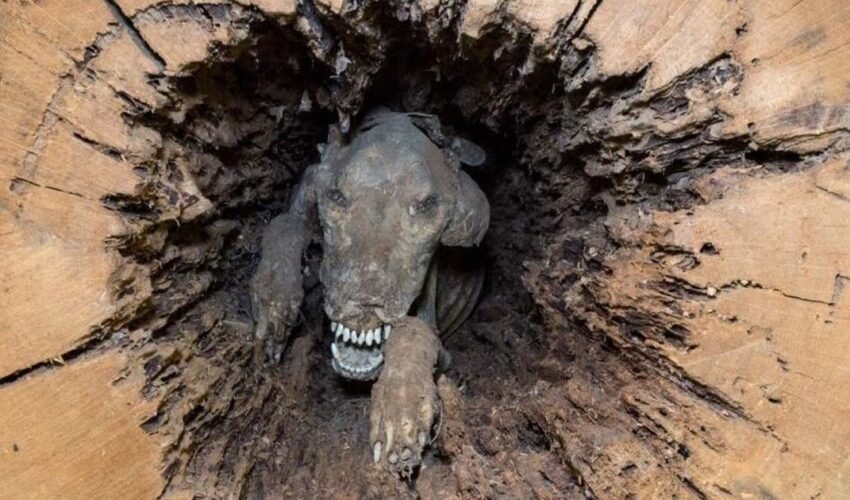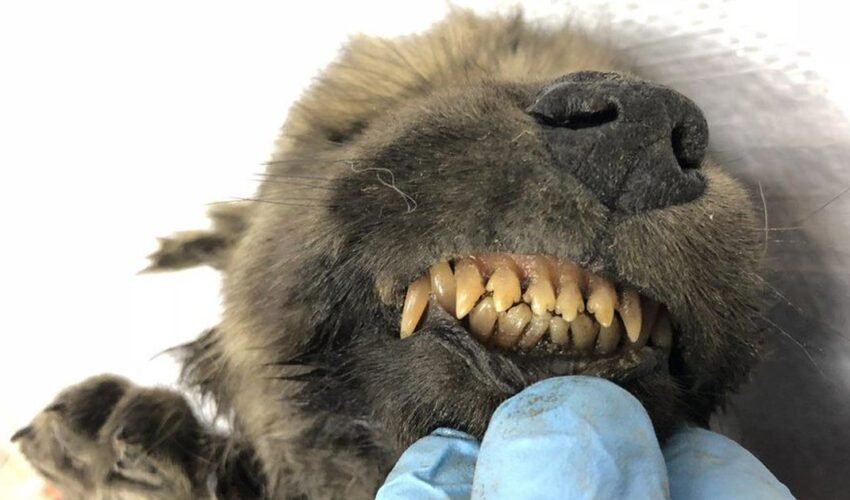“Stuckie”, the hunting dog was found inside a tree trunk 20 years after it got trapped inside while chasing a raccoon. It was a shocking find for the loggers, who were planning to cut the tree into pieces.

In 1980, while a team of loggers from The Georgia Kraft Corp. were cutting the top of a chestnut oak tree to prepare it for transportation, they stumbled upon an extraordinary sight. Inside the hollow space of the log, they were met with the gaze of a white and brown dog. Surprisingly, the dog’s body was remarkably well-preserved, even though it had not undergone any Egyptian mummification methods.
It was approximately 1960 when the hunting dog ran into a hole at the bottom of a tree and climbed 28 feet up, and about 20 years later, the loggers arrived to save the canine from his unfortunate fate. “Because he’s a hunting dog, we assumed he was chasing something in the tree,” Southern Forest World’s owner, Bertha Sue Dixon, told Newsweek. However, as the dog climbed higher, the tree gradually narrowed, eventually trapping him. He was never able to catch his prey, and no one noticed him inside the trunk. He remained in the unintentional trap, unable to escape or turn around, ultimately leading to his demise.
When the loggers discovered him, all that remained was a dried, mummified hound, petrified in an endless struggle to escape.
But the question remains as to how the dog’s body remained preserved for so long in the absence of an Egyptian mummification technique. The simple answer is that the properties of his wooden tomb did the work.

When a human or animal dies, the biological mechanisms that keep microbes under control are normally disrupted, leaving the body’s microbes unchecked. In the absence of normal guardians, they begin to eat the body, and the microorganisms in the gut begin the process of putrefaction.
“They grow, they reproduce, and they start taking over the body,” Kristina Killgrove, a biological anthropologist at the University of West Florida who studies decay in humans explained how the tree itself dry preserved the dog.
She further added, “That’s the disgusting part, the body bloats and decays, and bacteria, fungi, insects and other animals come to eat the remains.”
But the tree Stuckie was stuck in, prevented anything like this to happen, the chestnut oak became his coffin. It contains tannin, which is used to tan animal pelts and keeps them from decaying. Tannin is a material that dries out the surrounding and retains moisture, or a natural “desiccant.” It provided relatively dry conditions as oak’s tannic acid, helped to harden the animal’s skin.
Also, when an animal died in the wild, it was usually eaten by other animals within a day or two, but in the case of Stuckie, he was stuck inside a tree, and it was highly unlikely that other animals could reach it, and due to the height of the body, which was deep inside the tree, it was also unlikely that other animals could smell it.
Stuckie remained in a well-preserved state because the low moisture environment prevented any microbial activity, and no microbial activity means no decay.

Dixon explained that the position and the shape of the tree and the wind blowing upwards also helped Stuckie stay undetected for so long. It had like a chimney effect, (The movement of air into and out of buildings, chimneys, flue-gas stacks, or other containers caused by air buoyancy is known as the chimney effect. Buoyancy occurs as a result of a difference in indoor-to-outdoor air density caused by temperature and moisture variations).
Because of the air flowing in and out of the tree, animals were unable to detect a dead flash inside the tree.
“People always ask me, How did he get in there? And I always say, well he was a hound dog. Maybe he was after a raccoon.” Brandy Stevenson, Forest World’s manager told Roadside America.
The loggers took the mummified puppy to the museum after discovering it. Stuckie, the mummified dog whose name was chosen in a naming contest in 2002, is on display at Waycross, Georgia’s Southern Forest World Museum and Environmental Center.
If you liked reading about Stuckie the dog, check out The 18,000-Year-Old Frozen Puppy Leaves Scientists Puzzled











